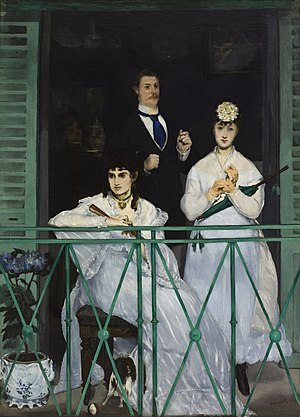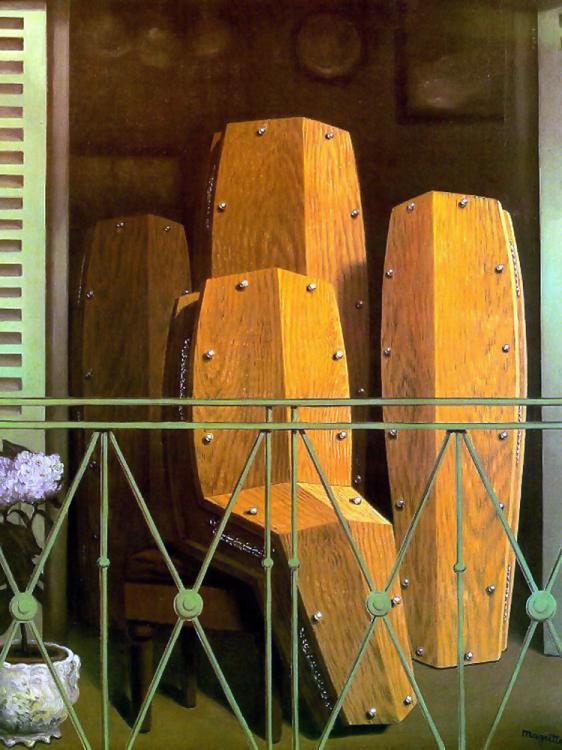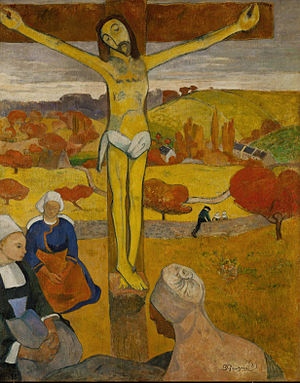General Discussion
Related: Editorials & Other Articles, Issue Forums, Alliance Forums, Region ForumsAh, I see you are back for MORE of the Friday Afternoon Challenge! Today: Inspiration!
These works inspired paintings by later artists. Can you identify the original work and the later ones?
...and what have I told you about cheating? Don’t.
1.
[IMG] [/IMG]
[/IMG]
2.
[IMG] [/IMG]
[/IMG]
3.
[IMG] [/IMG]
[/IMG]
4.
[IMG] [/IMG]
[/IMG]
5.
[IMG] [/IMG]
[/IMG]
6.
[IMG] [/IMG]
[/IMG]
jberryhill
(62,444 posts)#1 is an ancient work called "The Crucifixion of Bob" from about 500 BCE. It inspired the much later crucifixion of Jesus, and countless other artworks based on that.
CTyankee
(63,888 posts)jberryhill
(62,444 posts)The Temptation of Donald Duck:

CTyankee
(63,888 posts)but it is not a cartoon character...
jberryhill
(62,444 posts)It is an Etruscan tomb decoration which later inspired Cher's costume designer:

CTyankee
(63,888 posts)MattBaggins
(7,897 posts)pinboy3niner
(53,339 posts)
pinboy3niner
(53,339 posts)The inspiration for Manet's The Balcony:

[edit] Inspiration and descriptionThe painting, inspired by The Majas at the balcony by Francisco Goya, was created at the same time and with the same purpose as The Lunch in the workshop. The three characters, who were all friends of Manet, seem to be disconnected from each other: while Berthe Morisot, on the left, looks like a romantic and inaccessible heroine, the young violinist Fanny Claus and the painter Antoine Guillemet seem to display indifference. The boy in the background is Manet's son, Léon. Just behind the railings, there are a hydrangea and a dog with a ball.[2]
http://en.wikipedia.org/wiki/The_Balcony_(painting)
CTyankee
(63,888 posts)pinboy3niner
(53,339 posts)And discovered that Magritte also did a parody of the Manet using the same title:

Magritte, 'The Balcony'
CTyankee
(63,888 posts)Brickbat
(19,339 posts)He used Michelangelo's portrait of Isaiah at the Sistine Chapel for Rosie's pose (with "Mein Kampf" under her shoe).

CTyankee
(63,888 posts)Brickbat
(19,339 posts)Warren DeMontague
(80,708 posts)CTyankee
(63,888 posts)Warren DeMontague
(80,708 posts)Warren DeMontague
(80,708 posts)CTyankee
(63,888 posts)Warren DeMontague
(80,708 posts)But I can envision the painting.
CTyankee
(63,888 posts)Warren DeMontague
(80,708 posts)CTyankee
(63,888 posts)[IMG] [/IMG]
[/IMG]
pinboy3niner
(53,339 posts)Once Warren ID'd the artist, it was easy to find by googling Klimt's works (which is not cheating). There seem to be more than one version, but I think this is the right one:

The Portrait of Adele Bloch-Bauer I undoubtedly represents the culmination of Klimt's occupation with the portraiture of women. Inspired by the sixth-century mosaics of Empress Theodora that Klimt saw in Ravenna's Church of San Vitale, the painter created a monument to the glorification of female beauty, expending all the time and effort befitting an empress. Klimt's extensive use of gold leaf - while largely foregoing colour - and a deep awareness of artistic tradition combine to create the inimitable aura that sets the Viennese Jugendstil apart from similar artistic trends in other European centres. At the same time the detailed and finely delineated face of Adele Bloch-Bauer prevents the subject from disappearing into anonymity behind the universality of the picture.
http://www.austria.info/uk/art-culture/gustav-klimt-and-women-1545376.html
CTyankee
(63,888 posts)I saw it last summer. The back story on this painting is fascinating....a new book entitled "The Lady in Gold" outlines the history, which you will find riveting...an incredible and sometimes horrifying tale, but with a good ending at long last, when it became part of the permanent collection (thanks to Ron Lauder) at the Galerie...
pinboy3niner
(53,339 posts)Although at first sight the themes presented in the triptych seem extremely wide-ranging, they are actually linked, for St Christopher was the Arquebusiers' patron saint. When the triptych was closed, all that worshippers could see was this scene from the legend of St Christopher, whose Greek name 'Christophorus' means 'Christ-bearer'. This fact forms the key to the entire painting, in which the friends and holy women in the centre panel, and Mary and Simeon in the wings are also 'Christ-bearers'.
http://www.wga.hu/frames-e.html?/html/r/rubens/11religi/07desce.html
Rembrandt, The Descent from the Cross:

http://www.wga.hu/html_m/r/rembrand/12passio/02passio.html
CTyankee
(63,888 posts)It is paired with Rubens's magnificent "Elevation of the Cross." These two paintings are quite large. Very impressive. I was lucky to see the originals -- the museum where they usually are was under renovation. The cathedral had copies, but moved them somewhere else and put the originals in.
Unfortunately, the Rembrandt version, which is magnificent in other ways, is at the Hermitage and I don't see me going to Russia any time soon...
pinboy3niner
(53,339 posts)I haven't figured out whose work he inspired with this yet, but it may have been one of Botticelli's Lamentations or one by Andrea Solario. Perhaps others can help solve this.
The theme of the Lamentation of Christ is common in medieval and Renaissance art, although this treatment, dating back to a subject known as the Anointing of Christ is unusual for the period. Most Lamentations show much more contact between the mourners and the body. Rich contrasts of light and shadow abound, infused by a profound sense of pathos. The realism and tragedy of the scene are enhanced by the violent perspective, which foreshortens and dramatizes the recumbent figure, stressing the anatomical details: in particular, Christ's thorax. The holes in Christ's hands and feet, as well as the faces of the two mourners, are portrayed without any concession to idealism or rhetoric. The sharply drawn drapery which covers the corpse contributes to the dramatic effect. The composition places the central focus of the image on Christ's genitals - an emphasis often found in figures of Jesus, especially as an infant, in this period, which has been related to a theological emphasis on the Humanity of Jesus by Leo Steinberg and others.
Mantegna presented both a harrowing study of a strongly foreshortened cadaver and an intensely poignant depiction of a biblical tragedy. This painting is one of many examples of the artist's mastery of perspective. At first glance, the painting seems to display an exact perspective. However, careful scrutiny reveals that Mantegna reduced the size of the figure's feet, which, as he must have known, would cover much of the body if properly represented.[2]
Mantegna probably made this painting for his personal funerary chapel. It was found by his sons in his studio after his death and sold off to pay debts. The painting is now in the Pinacoteca di Brera of Milan, Italy.
http://en.wikipedia.org/wiki/Lamentation_of_Christ_(Mantegna)
CTyankee
(63,888 posts)I'm surprised that the one who was "inspired" wasn't listed in your research....
[IMG] [/IMG]
[/IMG]
pinboy3niner
(53,339 posts)I probably missed it because I searched on the 'Lamentation' title instead of the 'Dead Christ' title.
CTyankee
(63,888 posts)CTyankee
(63,888 posts)started a "school" here...there were some very interested American artists who joined him...
jberryhill
(62,444 posts)...but was this the school?

pinboy3niner
(53,339 posts)...with the one where Bush studied.
jberryhill
(62,444 posts)
CTyankee
(63,888 posts)in the late 19th century. However, the artist is much better known for his works in another part of the world.
pinboy3niner
(53,339 posts)Paul Gauguin, The Yellow Christ:

Gauguin first visited Pont-Aven in 1886. He returned to the village in early 1888 to stay until mid-October, when he left to join Vincent van Gogh in Arles, for little more than two months. Early in 1889, Gauguin was back to Pont-Aven to stay there until spring 1890. It was only for a short visit in summer 1889 to Paris to see the Exposition universelle and to arrange the Volpini Exhibition that Gauguin interrupted this sojourn. Soon after his return to Pont-Aven he painted The Yellow Christ:
The Yellow Christ was painted by Gauguin at Pont Aven in 1889. It is a symbolic piece that shows the crucifixion of Christ taking place in nineteenth century northern France as Breton women are gathered in prayer. Gauguin relies heavily on bold lines to define his figures and reserves shading only for the women. The autumn palette of yellow, red and green in the landscape echoes the dominant yellow in the figure of Christ. The bold outlines and flatness of the forms in this painting are typical of the cloisonnist style.
A study done in pencil of the Yellow Christ is preserved in the Thyssen-Bornemisza Museum, and a sketch in watercolor in the collection Chapman in New York.
http://en.wikipedia.org/wiki/The_Yellow_Christ
CTyankee
(63,888 posts)I just learned about Pont-Aven a few weeks ago. I had no idea that was where he painted all those women in their Breton caps. I literally ran across the reference for the first time when I was researching Road Scholar trips to France. The connection with some American artists of the time was also a fascinating bit of art trivia...
pinboy3niner
(53,339 posts)After the hint, I looked at a ton of stuff on art movements and schools in France before finding a reference to the village in Brittany.
Thanks for another great Challenge, CTyankee. ![]()
jberryhill
(62,444 posts)I'm gonna guess you didn't pick that up in basic training.
pinboy3niner
(53,339 posts)pinboy3niner
(53,339 posts)Recap of solvers' answers (subject to correction by CTyankee if I screwed it up):
1. The Crucifix of Trémalo, Pont-Aven (artist unknown); inspired Paul Gauguin's
The Yellow Christ
2. Andrea Mantegna - Lamentation of Christ (aka Dead Christ or Lamentation over the Dead Christ); inspired Annibale Carracci's Dead Christ
3. Michelangelo - The Prophet Isaiah; inspired Norman Rockwell's Rosie the Riveter
4. Goya - Majas on a Balcony. inspired Manet's The Balcony (which inspired Magritte's parody, The Balcony)
5. Rubens - Deposition from the Cross; inspired Rembrandt's The Descent from the Cross
6. Theodora, detail of a Byzantine mosaic in Basilica of San Vitale, Ravenna; inspired Klimt's Portrait of Adele Bloch-Bauer I
CTyankee
(63,888 posts)I've actually considered developing this more fully as a lecture to present at our area's Institute for Learning in Retirement, but have reservations since my cred is not academically in art history (mine is an MA in Liberal Studies, altho my BA is in Fine Arts). This is a pretty heavily degreed retirement population here in New Haven...I'm a bit intimidated...
pinboy3niner
(53,339 posts)And I hope you go ahead with your lecture idea. It's less a matter of 'cred' than an interest and willingness to take it on. How many Art History Ph.D.s are stepping up to do that? It's a great idea, and you're fully capable of doing it. I say, go for it!